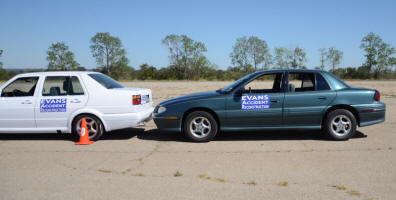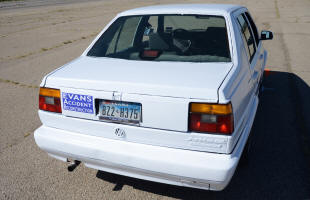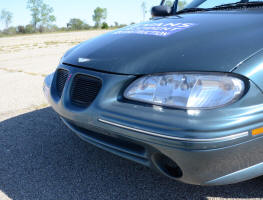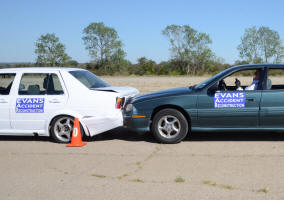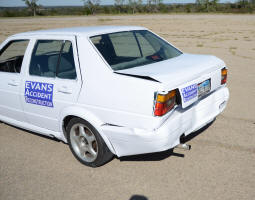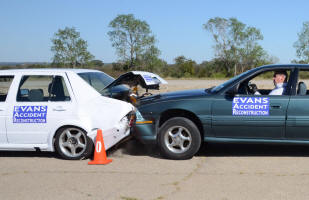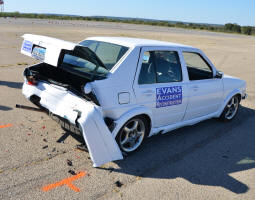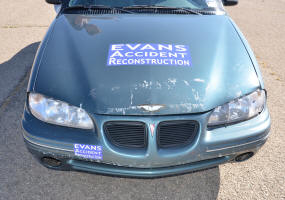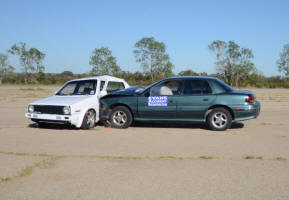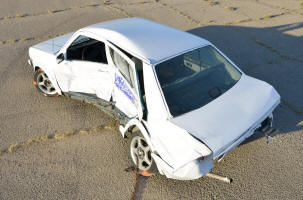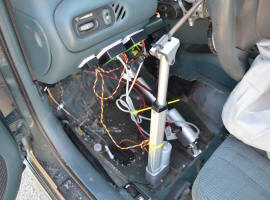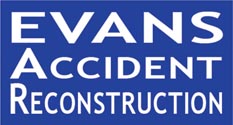
Office (979) 703-7227
Fax (979) 703-7247
24-Hour Crash Response (979) 575-9422
Crash Testing
Crash testing is rarely performed as part of an accident
reconstruction, as most accidents can be reconstructed using
NHTSA crash test data, computer modeling, mathematical
calculations and other methods. Crash testing is generally
performed for research purposes or to test vehicle
crashworthiness.
Crash demonstration may be a better term for the type of crash
performed by an accident reconstruction firm. There are times
when an aspect of an accident is difficult for involved parties
(such as jurors) to visualize and understand. A crash
demonstration can be a highly effective means to show how an
accident occurred.
In this demonstration, Evans Accident Reconstruction performed
four impacts – three rear impacts and one side impact. In all
impacts, the green Pontiac Grand Am struck the white Volkswagen
Jetta. The Jetta was painted white to provide a better visual
contrast and help viewers differentiate between the two
vehicles.
Click on the image below to view a crash
demonstrations performed by Evans Accident Reconstruction.
Click image above to play video
Photographs ofthe Volkswagen (white vehicle) and Pontiac (green vehicle)
The first impact was a 5 mph rear impact. The goal was to allow the Grand Am to strike the Jetta with enough force to alert the airbag system, yet be under the threshold for airbag deployment. The collision caused the Grand Am’s Airbag Control Module (ACM) to store data called a “non-deployment event”. After the impact, we downloaded or “imaged” the data in the ACM.
The second impact was at a higher speed of 12 mph. The airbag did not deploy, but a non-deployment event was recorded by the ACM. After this second impact, we again downloaded the ACM data.
The third impact was at a speed of 18 mph. Once again, the airbag did not deploy, but a non-deployment event was recorded by the ACM. The ACM data was again downloaded.
Why did the Airbags not deploy in these rear impacts? There are many factors that the airbag control module considers. The goal of the Airbag Control Module is to look at data from the sensors (the system is made of many different types of sensors) and try to anticipate the severity of the impact. In this case, the weights of the vehicles and the “stiffness” ( or you could say “softness” ) of the rear of the VW Jetta was such that the impact forces were not seen by the Pontiac’s Airbag Control Module as severe enough to deploy the airbags. If the Pontiac had been driven into a heavier or stiffer vehicle at 18 mph, the airbags would probably have deployed.
The last collision was an angled side impact, with the Grand Am striking the stopped Jetta at a speed of 39 mph. For this demonstration, the Pontiac was driven by a custom-made remote control to avoid injury. The Grand Pam airbag can be seen deploying in the impact photograph, below, and in the video.
The remote setup included a throttle servo, a linear actuator that controls steering and a linear actuator that controlled braking. Not unlike driving a toy RC car.
Using a laptop computer to retrieve the Airbag
Control Module data from the Pontiac Grand Am.
For more information about the data collected and
to see what may be involved in an accident reconstruction, please visit
the Example Accident Reconstruction page on
this website.


